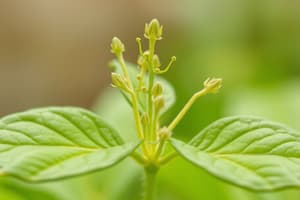Podcast
Questions and Answers
Qual é a função do ácido abscísico (ABA) em plantas?
Qual é a função do ácido abscísico (ABA) em plantas?
- Estimular a formação de flores e frutos
- Regular a germinação de sementes e prevenir a perda de água (correct)
- Inibir o crescimento e a diferenciação de raízes
- Promover a divisão celular e o crescimento
Qual é a função do etileno (ET) em plantas?
Qual é a função do etileno (ET) em plantas?
- Estimular o crescimento de caules e a expansão celular
- Regular a senescência das folhas e a queda de flores (correct)
- Promover a divisão celular e o crescimento de shoots
- Inibir a germinação de sementes e a formação de raízes
Quais são as principais funções dos citocininas em plantas?
Quais são as principais funções dos citocininas em plantas?
- Regular a abscisão de folhas e a senescência de flores
- Inibir a germinação de sementes e a formação de raízes
- Promover a divisão celular e o crescimento de shoots (correct)
- Estimular a formação de frutos e a expansão celular
Qual é a função dos giberelinas (GAs) em plantas?
Qual é a função dos giberelinas (GAs) em plantas?
Qual é a função dos auxinas em plantas?
Qual é a função dos auxinas em plantas?
Flashcards are hidden until you start studying
Study Notes
Plant Hormones
Plant hormones are chemical messengers that regulate various physiological processes in plants. There are five main types of plant hormones: Abscisic Acid, Ethylene, Cytokinins, Gibberellins, and Auxins.
Abscisic Acid (ABA)
- Involved in seed dormancy and germination
- Regulates stomatal closure to prevent water loss
- Plays a role in response to stress, such as drought, cold, and high salinity
- Inhibits cell growth and division
Ethylene (ET)
- Involved in fruit ripening and senescence
- Regulates abscission (leaf shedding) and flower senescence
- Stimulates root growth and differentiation
- Involved in response to stress, such as wounding and flooding
Cytokinins
- Promote cell division and growth
- Involved in shoot initiation and development
- Regulate root growth and differentiation
- Play a role in leaf senescence and abscission
Gibberellins (GAs)
- Involved in stem elongation and cell expansion
- Regulate seed germination and seedling growth
- Stimulate cell division and growth
- Involved in flower induction and development
Auxins
- Involved in cell elongation and cell division
- Regulate root growth and differentiation
- Stimulate shoot growth and development
- Play a role in apical dominance and tropisms (e.g., phototropism)
Note: These notes provide a brief overview of the main functions of each plant hormone. Each hormone has a more extensive range of functions, and there is often overlap and interaction between them.
Studying That Suits You
Use AI to generate personalized quizzes and flashcards to suit your learning preferences.



